

Lesson plans. National Poetry Month 2015: Twenty-Three Poetry Exemplars for the Common Core. Cherry tree blossoms around the Tidal Basin.
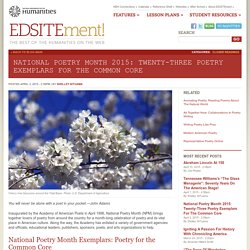
Photo: U.S. Department of Agriculture You will never be alone with a poet in your pocket. —John Adams Inaugurated by the Academy of American Poets in April 1996, National Poetry Month (NPM) brings together lovers of poetry from around the country for a month-long celebration of poetry and its vital place in American culture. National Poetry Month Exemplars: Poetry for the Common Core EDSITEment has assembled 23 examples of classic and contemporary poets and poems that can be integrated into your English Language Arts classroom. You will find a link to the poem and a host of open-source multimedia resources to teach it. The resources offer unique ways to build the content and skills for understanding poetry with English Language Arts classes.
Dear Poet This year for National Poetry Month, EDSITEment-reviewed Academy of American Poets presents Dear Poet. Poem in Your Pocket. 10 poems to read during National Poetry Month. In honor of National Poetry Day, TED-Ed asked writing teachers at the San Francisco Writers Grotto to recommend their favorite poems worth sharing.
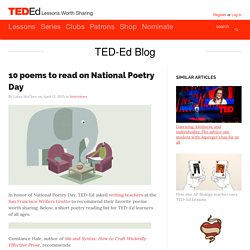
Below, a short poetry reading list for TED-Ed learners of all ages. Constance Hale, author of Sin and Syntax: How to Craft Wickedly Effective Prose, recommends: “Design” by Robert Frost For younger readers, I would go with some of the easier Robert Frost poems, which would set the stage for the more complex ones. “Design” is a great one for middle school students, allowing a good discussion of imagery and metaphor and rhyme (when it works and when it doesn’t) and structure … and the lessons of nature.
Pair with the TED-Ed Animation: The art of the metaphor. Caroline Paul, author of Lost Cat: A True Story of Love, Desperation, and GPS Technology, recommends: Billy Collins, in general Poetry is about concision, beauty — and the sudden swerve that tweaks the reality we thought we knew. Grace Rubenstein, multimedia editor of TED Books, recommends: Lesson Plan: Interpreting 'Howl' in the 21st Century. Overview | How can poetry both reflect and transcend the era in which it is written?
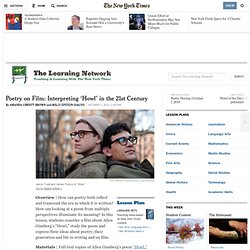
How can looking at a poem from multiple perspectives illuminate its meaning? In this lesson, students consider a film about Allen Ginsberg’s “Howl,” study the poem and express their ideas about poetry, their generation and life in writing and on film. Materials | Full-text copies of Allen Ginsberg’s poem “Howl,” computer with Internet access and projection equipment, video cameras and film editing software. Note to Teachers | “Howl” was banned after its publication in 1956 for obscene content. Though it prevailed in obscenity trials and has long been considered by many to be part of the canon, it may not be appropriate for all classes. Warm-up | Ask students to write briefly about what they expect from a film based on a poem. Discuss the following: Based on this trailer, what are your impressions of the poem, “Howl,” and the poet, Allen Ginsberg (played by James Franco)?
Digitalcommons.imsa.edu/cgi/viewcontent.cgi?article=1010&context=poetry. Texts From William Carlos Williams. This lesson explores the life and poetry of Emily Dickinson and how they relate. Poetry: Sound and Sense. ReadWriteThink couldn't publish all of this great content without literacy experts to write and review for us.
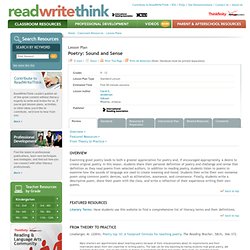
If you've got lessons plans, activities, or other ideas you'd like to contribute, we'd love to hear from you. More Find the latest in professional publications, learn new techniques and strategies, and find out how you can connect with other literacy professionals. More Teacher Resources by Grade Your students can save their work with Student Interactives. More Home › Classroom Resources › Lesson Plans Lesson Plan Overview Featured Resources From Theory to Practice Examining great poetry leads to both a greater appreciation for poetry and, if encouraged appropriately, a desire to create original poetry.
Back to top Literary Terms: Have students use this website to find a comprehensive list of literacy terms and their definitions. Linaberger, M. (2004). Onomatopoeia: A Figurative Language Minilesson. ReadWriteThink couldn't publish all of this great content without literacy experts to write and review for us.
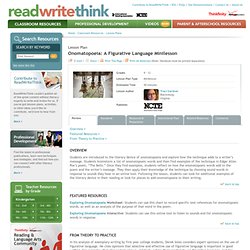
If you've got lessons plans, activities, or other ideas you'd like to contribute, we'd love to hear from you. More Find the latest in professional publications, learn new techniques and strategies, and find out how you can connect with other literacy professionals. More Teacher Resources by Grade Your students can save their work with Student Interactives. Rhyming Poem Lesson: Students Create Poems with Sound and Rhyme Techniques.
It is all about sound.
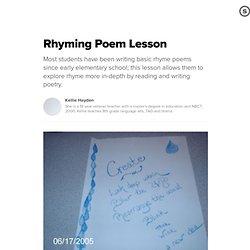
This poetry lesson on rhyming poems allows students to be creative with words and rhyming. Rhyme poems have a pattern or a rhyme scheme that can be any pattern that the student chooses. Preparation for the Poetry Lesson on Rhyme Poems Collect poetry books to share with the students that showcase rhyme patterns. Two great books to use with this lesson are A Kick in Head: An Everyday Guide to Poetic Forms [Ala Notable Children's Books.